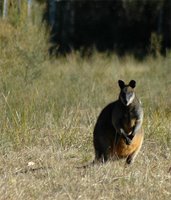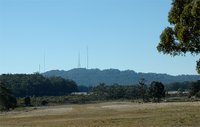 At left is my photo from this morning of a local resident, a Swamp Wallaby (Wallabia discolor). The biggest, wooliest, and fattest one I have ever seen! Rugged up for the winter, at the very least. It was not obviously carrying a joey in a pouch, so it may have been a male - but look at the "condition" on it. I would say it needs to go on a diet. It is a natural resident herbivore, and while some damage to the young plants is anticipated, there are not so many of them around as to cause too much trouble for the young plants.
At left is my photo from this morning of a local resident, a Swamp Wallaby (Wallabia discolor). The biggest, wooliest, and fattest one I have ever seen! Rugged up for the winter, at the very least. It was not obviously carrying a joey in a pouch, so it may have been a male - but look at the "condition" on it. I would say it needs to go on a diet. It is a natural resident herbivore, and while some damage to the young plants is anticipated, there are not so many of them around as to cause too much trouble for the young plants.*****
The natural boundary of this plateau is the volcanic formation known as Knight's Hill. This is a basalt outcrop which happens to be right on the edge of the Illawarra Escarpment, which explains why it has been used as a platform for television and other broadcast towers for the  Wollongong Region.
Wollongong Region. On the inland side of Knight's Hill is a slightly sloping sandstone plateau, with typical shallow sandy soil, and depending upon how deep the rock-base is, the soil might vary from being well-drained to quite boggy (if the soil is very shallow, the rock base acts to dam any moisture from penetrating deeply, and hence moisture has to flow slowly across the slightly sloping rock base).
 I remember as a gardener in Canberra trying to grow the NSW Christmas Bells, and reading that they needed "moist, well-drained soil". I thought what is that? This is their natural environment.
I remember as a gardener in Canberra trying to grow the NSW Christmas Bells, and reading that they needed "moist, well-drained soil". I thought what is that? This is their natural environment. When there is no rain, the soil dries out quickly. But after rain, moisture from miles away can move in a slow-moving flow, across, or rather "through" the soil. The soil on this property today was sodden, with visible flows in some places, but mostly not visible, just the soil was squishy. Hence that seemingly contradictory definition of "moist, well-drained soil" does make sense - at least, in shallow, nearly flat, sandstone plateaux. I never managed to re-create those conditions in my Canberra garden.

Some of the plants which grow here are classic "wet area" plants, such as the tiny bronze-coloured primitive plants known generally (but not accurately) as "Club Moss" (Selaginella gracillima).
 Another common local plant is the "Coral Fern" (Gleichenia dicarpa) See photo below. This plant loves sloping banks, alongside roadways, and on cliff lines, with moisture flowing through cracks in rock shelves. Yet here it is growing in moist sandy soil.
Another common local plant is the "Coral Fern" (Gleichenia dicarpa) See photo below. This plant loves sloping banks, alongside roadways, and on cliff lines, with moisture flowing through cracks in rock shelves. Yet here it is growing in moist sandy soil. Other plants are dry soil plants, such as Hakea dactyloides and Persoonia mollis.
 The taller trees are mostly Eucalyptus seiberii (Silvertop Ash) and E. gummifera (Red Bloodwood). For similar areas, in the neighbouring Budderoo National Park, have a look at the "plant communities" lists for Eucalypt forest, woodlands and heathlands.
The taller trees are mostly Eucalyptus seiberii (Silvertop Ash) and E. gummifera (Red Bloodwood). For similar areas, in the neighbouring Budderoo National Park, have a look at the "plant communities" lists for Eucalypt forest, woodlands and heathlands.I should mention that this property is within about 500 metres of the edge of the cliffs which form the Upper Kangaroo Valley. So, although this area is flat (or nearly so), it suddenly drops to nearly vertical edges, with "warm temperate rainforest" patches in the gullies below. Classic Sandstone cliffs are just a short walk from this flat property.
The Sandstone Plateau is a land of contrasts, and apparent contradictions.

No comments:
Post a Comment